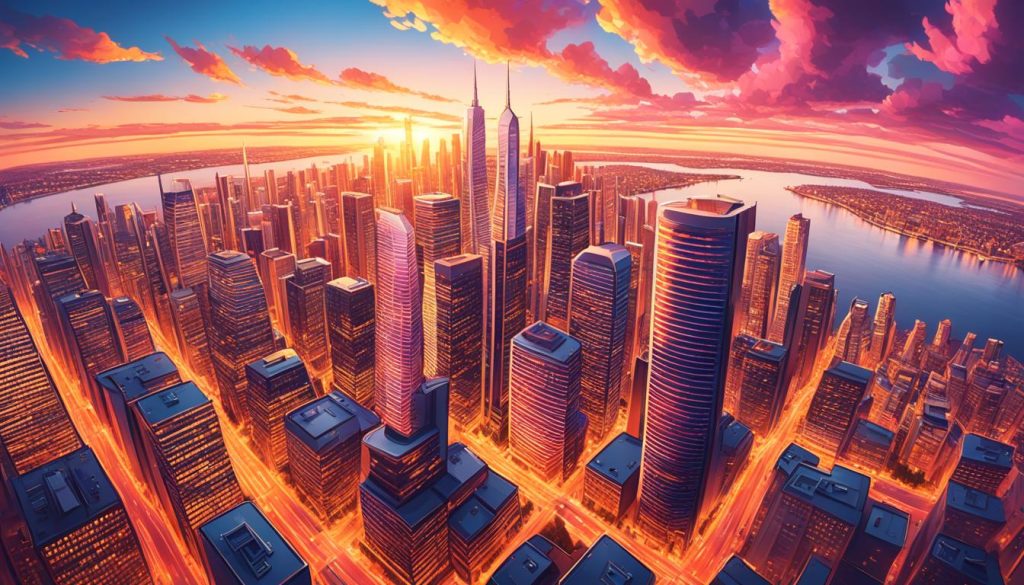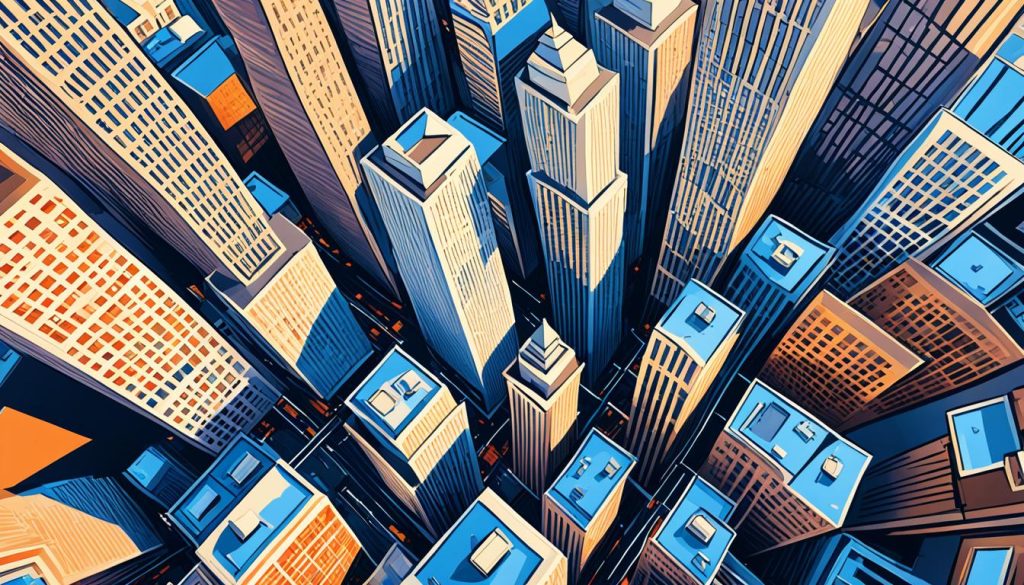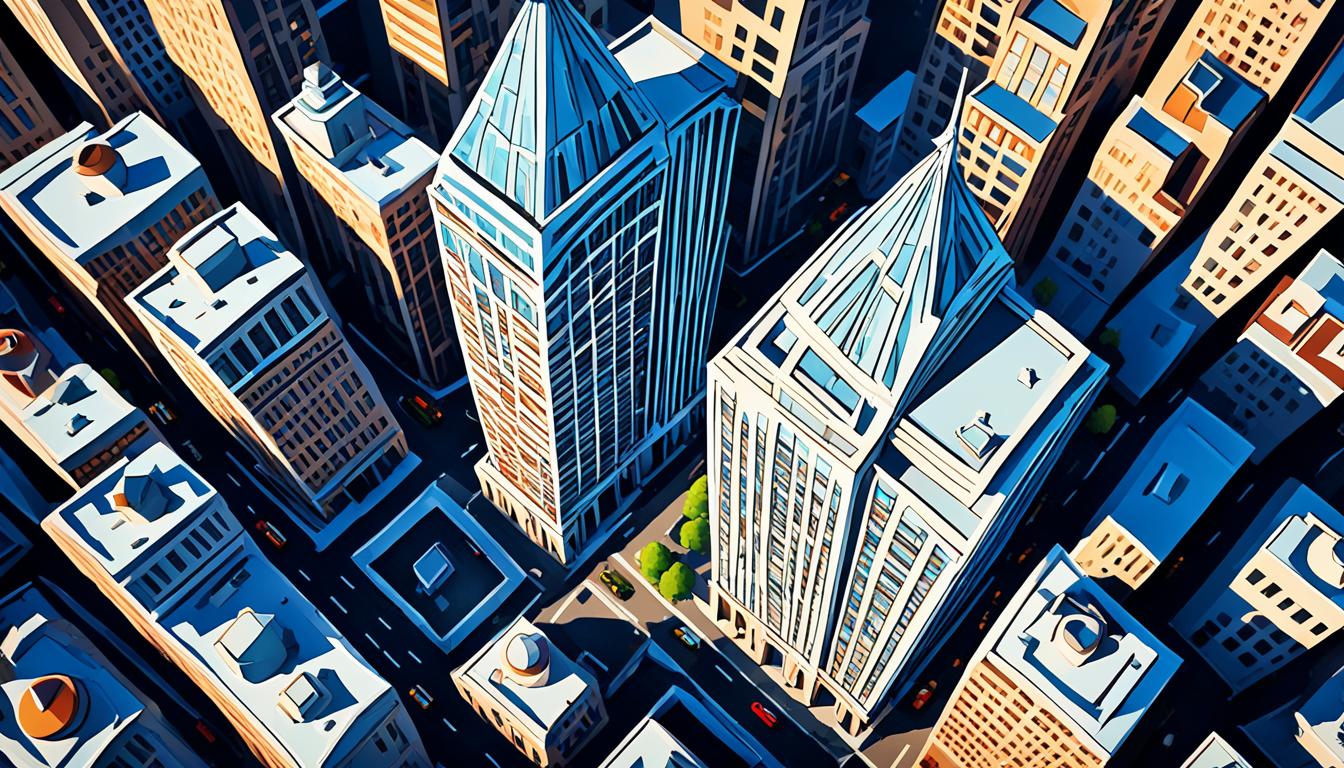You can take amazing photos of skyscrapers with your drone by learning special techniques. This way, you can show off whole cities in one stunning picture. It’s a unique way to capture urban scenes and buildings.
To get great shots, you need to know about GPS mode for stability, how to set your camera manually, and how to keep the white balance right. These are key for making smooth vertical panoramas that show off skyscrapers and city scenes well.
Your drone is a big part of getting these amazing shots. For example, the DJI Air 2S has a 1-inch camera sensor. It’s great for taking clear photos in low light and HDR panoramas. It’s perfect for capturing cityscapes from above.
With the right gear, skills, and editing, you can make vertical panoramas that give a new view of the city. These photos are great for real estate ads, city planning, and art projects that highlight modern city heights.
Understanding Vertical Panoramas in Aerial Photography
Vertical panoramas are changing how we see cities from above. They show tall buildings from the ground up, giving us a new view. This makes the images stand out.
Definition and Unique Characteristics
Vertical panoramas are photos taken from above that focus on tall subjects. They use drones or special cameras. Unlike regular photos, they highlight height over width. This lets photographers capture tall buildings and monuments in one shot.
Advantages over Traditional Aerial Shots
Vertical panoramas have many benefits over regular aerial photos:
- They show the whole structure and its area
- They give a deep look into the scene from the ground up
- They offer a new view of well-known places
- They capture detailed features of buildings
Applications in Urban Landscapes and Real Estate Marketing
Vertical panoramas are great for city photos and real estate ads. They’re perfect for:
- Showing off city skylines and buildings
- Highlighting the size and beauty of skyscrapers
- Marketing multi-story buildings
- Making eye-catching visuals for tourism and city branding
These uses make vertical panoramas a key tool for showing city life and marketing tall buildings.
Essential Drone Equipment for Vertical Panoramas
To get amazing shots of skyscrapers, you need the right gear. A top-notch aerial camera is key for clear shots, especially when it’s dark. The DJI Air 2S is great for city photos because of its 1-inch sensor.
A stable gimbal is a must for smooth shots. It keeps your camera steady, so your photos are sharp. Choose drones with the latest gimbal tech to reduce shakes and keep control.
GPS drones are better for steady panoramic shots. They stay put in the wind, letting you focus on your shot. Don’t forget these extras for your drone:
- Extra batteries for longer flights
- ND filters for bright skies
- Propeller guards for safe flying
- A good case to protect your gear
Quality drone gear makes a big difference in your vertical shots. With the right tools, you’re set to capture stunning city views. These shots will make your aerial photography stand out.
Configuring Your Drone for Optimal Performance
To get amazing shots of skyscrapers from above, you need to set up your drone right. This means setting GPS mode and tweaking camera settings for top-notch results.
Setting up GPS mode
GPS mode is key for keeping your drone steady while taking vertical shots. Turn it on to keep your drone in one spot. This helps you get sharp, aligned photos for your panorama.
Adjusting camera settings
Put your drone camera in manual mode for full control. Choose a low ISO to cut down on noise in your shots. Adjust the shutter speed depending on how bright it is outside. Use a faster shutter speed for bright skies to avoid overexposure.
Locking white balance
Keeping colors consistent is important for panoramas. Lock your white balance to keep tones even across all shots. This stops color shifts that auto settings might cause.
For HDR panoramas, use bracketed exposures. Set your camera to take several shots at different settings. This captures details in both bright and dark parts of your scene.
Adjust exposure compensation for the lighting. In bright scenes, try -1 EV to stop the sky from getting too bright. These tips will help you make beautiful vertical skyscraper panoramas with your drone.
Mastering Drone Flight Techniques for Vertical Shots
To get amazing vertical shots, you need to learn special drone flying skills. These skills help you do cool aerial moves and take beautiful vertical photos. Let’s look at the key techniques you should master.
First, work on flying up and down smoothly. This is key for vertical photos. Start with slow, steady moves, then speed up as you get better. Having steady hands and precise control is important for clear photos.
Using the pause button on your controller is a big help for vertical shots. It lets you freeze your drone in place, so you can adjust your camera or change your shot. It’s great when the light changes or you want to catch a special moment in your photo.
For drones like the DJI Inspire, use the second controller to turn the camera gimbal. This makes smooth panning easy while keeping your drone steady. If your drone has a fixed camera, use the left stick to turn the drone for panning.
- Practice vertical ascents and descents
- Use the pause button for precise positioning
- Rotate the camera gimbal for smooth panning
- Maintain consistent distance from the subject
Keeping a steady distance from your subject is key for vertical photos. This keeps everything in focus and the same brightness. Begin by flying at a set distance from your subject. Then, move up and down while keeping that distance the same.
By improving these flying skills, you’ll be ready to take amazing vertical photos. These photos will show off cityscapes in a big way.
Capture Stunning Skyscraper Vertical Panoramas with Your Drone
Using drones for skyscraper photography opens up new ways to make amazing vertical panoramas. This guide will show you how to get great results in your city shots from above.
Step-by-Step Shooting Process
Begin your vertical panorama at the skyscraper’s base. Fly your drone up, taking shots that overlap by 20-50% each time. This method is key to creating smooth vertical panoramas.
Optimal Camera Angles and Positioning
Position your drone for the best shot. Use the rule of thirds for balanced shots. Place important parts of the building on these lines or where they meet. This makes your skyscraper photos more interesting and deep.
Managing Exposure in Varying Light Conditions
Getting the right exposure is key for skyscraper photos, especially for vertical shots. Use bracketed shots to capture details in bright and dark areas. In low light, slow down your shutter speed to about 1/10 second and keep your drone steady. Adjust your camera settings, usually -1 EV for bright skies, to avoid overexposure.
| Light Condition | Shutter Speed | Exposure Compensation |
|---|---|---|
| Bright Daylight | 1/500 – 1/1000 sec | -1 to -2 EV |
| Overcast | 1/250 – 1/500 sec | 0 to -0.5 EV |
| Sunset/Sunrise | 1/60 – 1/250 sec | +0.5 to +1 EV |
| Night | 1/15 – 1/60 sec | +1 to +2 EV |
Choosing the Right Time and Weather Conditions
Finding the perfect moment for your drone photos is key. The timing and weather affect how stunning your skyscraper shots will look. They can make your urban landscapes shine.

Golden hour is a dream for drone lovers. It happens right after sunrise or before sunset. The city looks warm and soft during this time. Skyscrapers cast long shadows, making buildings stand out.
Blue hour is another great time. It’s the twilight before sunrise or after sunset. The sky turns deep blue, and lit buildings create stunning contrasts. This makes for amazing vertical shots that capture the city’s buzz.
Weather matters a lot for drone photos. Overcast days can be good because they light everything evenly. But for the clearest shots, fly on calm days with winds under 10 mph.
| Time of Day | Lighting Characteristics | Best for Capturing |
|---|---|---|
| Golden Hour | Warm, soft light | Architectural details, long shadows |
| Blue Hour | Deep blue sky, city lights | Urban energy, illuminated buildings |
| Overcast Day | Even, diffused light | Intricate building textures |
Think about the seasons when planning your drone shoots. Summer has longer golden hours, and winter shows off buildings with bare trees. Mastering timing and weather will take your vertical shots to the top.
Composition Techniques for Impressive Skyscraper Panoramas
To make stunning vertical panoramas of skyscrapers, learn composition techniques. These skills help you capture the beauty of tall buildings and cityscapes. Let’s look at key strategies to improve your aerial photos.
Utilizing the Rule of Thirds in Vertical Layouts
Use the rule of thirds vertically for balanced and attractive images. Split your frame into three equal parts up and down. Put important parts of the skyscraper at these line crossings. This makes the viewer look at the skyscraper’s key features.
Incorporating Leading Lines and Patterns
Use the skyscraper’s edges as leading lines to lead the viewer’s eye. Look for architectural patterns like repeated windows or structural details. Find geometric shapes and symmetry in the building’s design for interesting compositions.
Balancing Sky and Architecture in the Frame
Get the right mix of sky and building in your vertical shots. Aim for a 1:2 or 1:3 ratio of sky to building. This highlights the skyscraper’s height and adds context with the sky.
| Composition Technique | Purpose | Application |
|---|---|---|
| Rule of Thirds | Create balance | Place key elements at intersections |
| Leading Lines | Guide viewer’s eye | Use building edges and structural lines |
| Architectural Patterns | Add visual interest | Highlight repeated elements in design |
| Sky-to-Building Ratio | Emphasize height | Aim for 1:2 or 1:3 sky to architecture |
By using these composition techniques, you’ll make amazing skyscraper panoramas. They’ll show the beauty and grandeur of city architecture. Try different methods to find your special style in vertical drone photography.
Post-Processing Workflow for Vertical Panoramas
Post-processing is key to making stunning vertical panoramas. Start by importing and organizing your images. Group your shots by when you took them, focusing on AEB (Auto Exposure Bracketing) sets. This makes editing easier and helps you handle lots of photos.
Next, merge AEB exposures to create High Dynamic Range (HDR) images. This boosts the quality of your vertical panorama. Use software like Lightroom for this, as it has great tools for HDR merging and stitching panoramas.

For stitching panoramas, use the Perspective option in Lightroom. It’s made for vertical panoramas, ensuring your images blend well. After stitching, fix any distortion with the Transform panel. This is important for keeping straight lines and right proportions in your skyscraper shots.
Improve your panorama by adjusting exposure, contrast, and color balance. These changes make your cityscapes look better. But remember, sometimes, using fewer frames can make your final shot better.
| Post-Processing Step | Tool/Technique | Purpose |
|---|---|---|
| Image Organization | Lightroom Stacking | Group AEB sets |
| HDR Creation | AEB Merging | Enhance dynamic range |
| Panorama Stitching | Perspective Option | Blend vertical shots |
| Distortion Correction | Transform Panel | Fix perspective issues |
| Final Adjustments | Exposure/Color Tools | Refine visual appeal |
Software Tools for Stitching and Editing Panoramas
Turning your drone shots into stunning vertical panoramas needs the right software. Let’s look at some top tools and methods to make your cityscapes stand out.
Popular Panorama Stitching Software
Panorama stitching software is key for merging images into a single vertical panorama. Top picks are PTGui, Hugin, and AutoPano Giga. These tools have advanced features like automatic alignment and blending. They’re perfect for complex urban scenes.
Lightroom and Photoshop Techniques
Adobe Lightroom and Photoshop are great for editing panoramas. In Lightroom, use the Merge to Panorama feature with Perspective projection for fast results. Photoshop’s Photomerge lets you fine-tune alignment and blending for tough cityscape panoramas.
Enhancing Urban Textures
To make your skyscraper panoramas stand out, focus on enhancing urban textures. Reduce noise in sky areas. Use dehaze and clarity tools to highlight building details. Try local adjustments to balance exposure, making every part of your cityscape shine.
- Apply selective sharpening to emphasize building edges
- Use gradient filters to balance sky and ground exposure
- Adjust contrast locally to highlight unique architectural features
Mastering these software tools and techniques lets you create amazing vertical panoramas. They’ll show off urban landscapes in all their glory.
Overcoming Common Challenges in Vertical Panorama Drone Photography
Vertical panorama drone photography can be tricky. You might face several drone photography challenges as you capture skyscrapers and tall structures. Let’s explore some common vertical panorama issues and how to troubleshoot them.
Parallax errors often occur when shooting vertical panoramas. To avoid this, keep a consistent distance from your subject as you move the drone. This helps maintain a uniform perspective throughout the image.
Changing light conditions can ruin your vertical panoramas. Use bracketed exposures to capture a range of light levels. This gives you more flexibility when editing later.
Low light situations pose another challenge. Use slower shutter speeds to let in more light. Your drone’s stability will help keep the image sharp.
- Ultra-wide panoramas may suffer from distortion
- Large file sizes can slow down processing
- Wind can affect drone stability during shots
To fix distortion in ultra-wide panoramas, use post-processing software. It can correct warped lines and unnatural curves. For large file sizes, only merge the necessary frames. This reduces processing time and storage needs.
Wind can throw off your drone’s position. Wait for calm weather or use your drone’s wind resistance features. This ensures steady shots for your vertical panoramas.
By addressing these challenges, you’ll capture stunning vertical panoramas of skyscrapers and cityscapes. Practice these techniques to improve your drone photography skills.
Legal Considerations and Drone Regulations for Urban Photography
When you’re taking photos of tall buildings with a drone, you need to know the rules. The FAA has strict guidelines for flying drones in cities. These rules help keep everyone safe and protect privacy.
Always keep an eye on your drone while it flies. This rule is key to avoiding accidents and staying aware of what’s around you. If you plan to use drones for work, getting a Part 107 license is a good idea. It shows you know the rules and might be needed for professional projects.
In cities, there are places you can’t fly your drone and height limits you must follow. Before you fly, check the local laws and get any needed permits. Remember to respect people’s privacy and property when taking photos. By doing this, you can make amazing photos while following the rules in cities.






